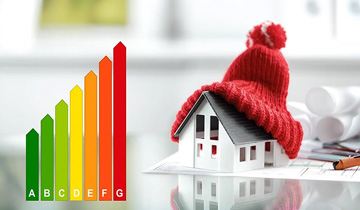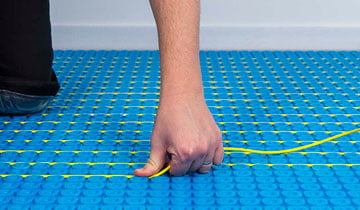9 min read
Can electric underfloor heating be used as a primary source of heat?
When you ask a group of people if electric underfloor heating can be used as a primary heat source, more often than not you’ll get a mix of...

If you are looking for energy saving tips on the internet, you’ll be presented a whole heap of different options. From not using a tumble dryer to ensuring electrical appliances aren’t left on standby. For this article we are focussing on reducing the running cost of electric heating as well as debunking some myths.
First thing’s first, the cost per kilowatt hour of electricity is more expensive than the gas equivalent. There’s no getting away from it (yet), however electric heating is much more efficient so every pound you spend is transferred into heat.
Efficiency
Electric heating is 100% energy efficient which means that every penny you spend gets converted into heat. If your home is well insulated, then electric heating is a great option.
Environment
With the growth of renewables, electricity continues to rise in popularity as a very low carbon source of energy and heat. Electricity is more expensive than gas, however electric heating is 100% efficient at point of use. This means you don’t need your heating on for as long to reach you ideal comfort level. It’s ideal if you are off the grid or just want to make your home heating more sustainable.
Control
Controlling electric heating is easy. The advances in controlling electric heating have made it easier to just heat the rooms you need to, so there’s no wasted heat from heating spaces that aren’t occupied. Smart heating controls also help you to efficiently run your electric heating which saves you money on your heating bills.
Installation
Electric heating is much easier to install than gas. It’s ideal for new build and retrofit projects and most electric heating systems can be installed by a competent DIYer. But, before you start any installation, ask your electrician for advice on electrical load and ensure that they always make the final connection to the mains.
Maintenance
Gas fuelled heating systems start to lose out when it comes to maintenance costs. The average one-off annual boiler service can range between £80 – £120. Products like HomePlan by Corgi could give you peace of mind by providing annual boiler and home emergency cover and can include the annual boiler service and cost between £13 – £21 per month depending on the level of cover. Just remember to read the small print and see what is not covered.
If you decide to go with electric heating such as electric radiators or electric underfloor heating. There is no maintenance required and therefore no service plans needed.
Give your home insulation a boost!
One of the best ways to save on running electric heating is to ensure your home is not losing too much heat. The UK has some of the worst insulated homes in western Europe which makes it more of a challenge too. According to Northern Energy, around 35% of heat is lost due to poorly insulated walls and 10% of heat is lost via windows (Department for Business, Energy & Industrial Strategy).
If you are living in a pre-1930s built home, you most likely have solid walls, and it would be more costly to insulate them either by external or internal wall insulation. Most houses built after the 1930s will have cavity walls which are easier and cheaper to insulate by injecting insulation directly into the cavity.
When it comes to windows, replacing single glazed for double or triple glazed windows would help retain the heat much better. But unfortunately, this is another expensive option. A more cost-effective option could be to apply window film to the glass which forms an additional retention layer on your windows to help reduce heat loss.
No matter what heating system you have, heat rises so another important part of insulating your home is to ensure you have adequate insulation in your loft. According to the Energy Saving Trust, about 25% of heat is lost through the roof in a poorly insulated home so making sure your loft is well insulated will help to reduce running costs of heating your home.
Finally, heat can be lost through the floor. It’s one of the main reasons we always recommend insulation board when installing electric underfloor heating. If it isn’t insulated, 50% of the heat generated will be lost through the substrate which will cost you more to run because it will take twice as long for your room to reach your desired temperature. If you already have electric underfloor heating installed under carpet and are thinking about upgrading your carpet for something thicker, remember that the absolute maximum tog rating to use is 2.5 because it may cause the heating system to work harder to get the heat into the room. This is because the carpet will trap air, which acts as an insulator. We always recommend that you triple check with the manufacturer if the carpet you are thinking about buying is suitable for underfloor heating.
Control your heating more efficiently
The Energy Saving Trust suggests if you reduce the temperature of a room by 1°C it can reduce heating bills by up to £75, perhaps even more since the latest increase in cost of energy.
Programmable thermostats are a perfect way to set up heating schedules and automatically adjust the temperature of any room to your required level at the time when you want it.
For the more tech-savvy homeowner who enjoy using smart technology, a smart thermostat could be the perfect choice. As well as having accurate temperature sensors, most smart thermostats include other energy saving functions. No matter where you are in the world, smart thermostats let you control your electric heating whenever you are connected to the internet. Some also include geo fencing which means that if you leave home and have left the heating on, it will turn off once you’re out of a predefined range. By embracing interconnectivity of a smart thermostat, you can control electric heating via an app and/or control it with your voice using smart speakers such as the Amazon Echo.
Another important point is that the Committee on Climate Change recommends thermostats are set no higher than 19°C to help combat global warming. So next time you are setting your heating schedule, stick to a maximum of 19°C if you can.
There are a wide variety of government-backed support to help low-income households such as the Energy Company Obligation (ECO). It is a government energy efficiency scheme in Great Britain that has been designed to tackle fuel poverty and help reduce carbon emissions. To reap the benefits from ECO you must own your own home or have permission from your landlord. This includes if your property is owned by a social housing provider.
So, when you have running electric heating, ensuring you home is well insulated and you are controlling it effectively will both help you save on your energy bills in the long run. If you have any questions about electric heating, please contact our team who are always on hand with helpful advice that can save you both time and money.

9 min read
When you ask a group of people if electric underfloor heating can be used as a primary heat source, more often than not you’ll get a mix of...

8 min read
If you are in the market for an electric underfloor heating system for your next home renovation, then you have landed in the perfect place. We’ve...

9 min read
If you are researching the feasibility of electric underfloor heating for your home, you may see a lot of examples that simply talk about underfloor...